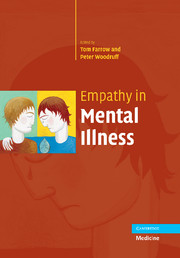Book contents
- Frontmatter
- Contents
- Foreword
- List of contributors
- Part I ‘Dysempathy’ in psychiatric samples
- 1 Empathic dysfunction in psychopathic individuals
- 2 Empathy deficits in schizophrenia
- 3 Empathy, antisocial behaviour and personality pathology
- 4 Empathy and depression: the moral system on overdrive
- 5 Empathy, social intelligence and aggression in adolescent boys and girls
- 6 Impaired empathy following ventromedial prefrontal brain damage
- 7 Non-autism childhood empathy disorders
- 8 Empathy and autism
- Part II Empathy and related concepts in health
- Part III Empathy models, regulation and measurement of empathy
- Index
1 - Empathic dysfunction in psychopathic individuals
from Part I - ‘Dysempathy’ in psychiatric samples
Published online by Cambridge University Press: 17 August 2009
- Frontmatter
- Contents
- Foreword
- List of contributors
- Part I ‘Dysempathy’ in psychiatric samples
- 1 Empathic dysfunction in psychopathic individuals
- 2 Empathy deficits in schizophrenia
- 3 Empathy, antisocial behaviour and personality pathology
- 4 Empathy and depression: the moral system on overdrive
- 5 Empathy, social intelligence and aggression in adolescent boys and girls
- 6 Impaired empathy following ventromedial prefrontal brain damage
- 7 Non-autism childhood empathy disorders
- 8 Empathy and autism
- Part II Empathy and related concepts in health
- Part III Empathy models, regulation and measurement of empathy
- Index
Summary
Introduction
Psychopathy can be considered one of the prototypical disorders associated with empathic dysfunction. Reference to empathic dysfunction is part of the diagnostic criteria of psychopathy (Hare, 1991). The very ability to inflict serious harm to others repeatedly can be, and is (Hare, 1991), an indicator of a profound disturbance in an appropriate ‘empathic’ response to the suffering of another. The goal of this chapter will be to consider the nature of the empathic impairment in psychopathy.
First, I will consider the disorder of psychopathy and the definition of empathy. Second, I will consider whether individuals with psychopathy are impaired in ‘cognitive empathy’ or Theory of Mind. Third, I will consider the cognitive and neural architecture mediating ‘emotional empathy’. Fourth, I will consider whether individuals with psychopathy are impaired in ‘emotional empathy’.
The disorder of psychopathy
The origins of the concept of psychopathy probably originate in the writings of Pritchard (1837); see Pichot (1978). Pritchard developed the concept of ‘moral insanity’ to account for socially damaging or irresponsible behaviour that was not associated with known forms of mental disorder. He attributed morally objectionable behaviour to be a consequence of a diseased ‘moral faculty’. While the notion of a ‘moral faculty’ has been dropped, modern psychiatric classifications such as the American Psychiatric Association's Diagnostic and Statistical Manual (currently, DSM-IV) make reference to syndromes associated with high levels of antisocial behaviour: conduct disorder (CD) in children and antisocial personality disorder (APD) in adults.
- Type
- Chapter
- Information
- Empathy in Mental Illness , pp. 3 - 16Publisher: Cambridge University PressPrint publication year: 2007
- 9
- Cited by



